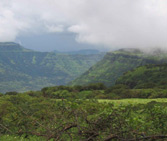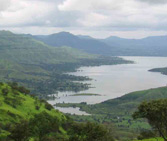HOME GROWN STORIES
The Sahyadris are my home. I am fortunate to live in a section of
the
Sahyadris that was once the abode and lair of the great king,
Shivaji. His famous fort, Sinaghad, towers above my
farmhouse. Torna, another impregnable fort of
his, is just a couple of valleys south.
I also share a fence with
the National Defence
Academy campus, and the
deer and peacocks that inhabit the Academy’s forests often cross
into my garden.
It was in these mountains that as a teenager I ventured forth on my
first trek. That trek kindled something deep inside me, setting off
a spark that still flames. I have followed up on that first walk with
hundreds of other forays into the Sahyadris. Even today, I venture
out into these fabulous hills as often as I can – especially
during the monsoons.
Mumbai is my other home. It is the city where I spent my childhood.
Both Mumbai and the Sahyadris are at the core of my Sahyadri books.
Unlike my other stories that describe far away lands, this is the
first time I have written one that is set in my home territory.
STORY INSPIRATION
If ever you venture out into the Sahyadris during the rains you
will see what inspired me to write these books. The Sahyadris are
wild and beautiful mountains. The rains enhance their rugged charm,
adding clouds and the mists and waterfalls. The mountain slopes
turn green and the wind is so strong that it can sweep you off your
feet.
There is adventure, romance and great beauty in these mountains.
Unfortunately few youngsters visit and sample what the Sahyadris
offer. The books are an attempt to inspire you to discover and enjoy
these mountains.
|



|
|
My Sahyadri stories are inspired also by Mumbai, particularly a great
mystery that lies at the very heart of the city. This mystery has
been around from the time I was born and from well before, as I was
to discover. The mystery is to do with this place in Mumbai called
‘Fort’. When I was a child growing up in Mumbai, my father worked in
this Fort. Every time I visited my dad’s office I would look for this
Fort but I never found any traces of it – there were no walls, no
ramparts, no gates. Yet, despite the absence of any signs of a fort,
this area of Mumbai is still called Fort. When I delved deeper into
this mystery, I discovered this Fort. I found that it is a piece of
our history that has simply vanished from public consciousness. In
the process I discovered also a beautiful, genteel city (Bombay of
old); a city that fascinated me so much that I had to tell its story…
CELLPHONE ALLEY
This name was coined by my friend, Ashok Captain. Ashok, for those
who don’t know, is one of India’s foremost authorities on snakes.
At one time Ashok would visit the fort of Torna on a regular basis
to search the fort’s walls (particularly at night) for a certain species
of snake. There is one ridge on the climb to Torna which if you traverse
on a windy monsoon day, you are most likely to be blown off your feet.
The wind strikes you from one side, assailing only one of your ears
– the one that faces the wind – much like a cellphone which also troubles
just one ear. Ashok always felt as if a cellphone was attached to
his ear while crossing this ridge…hence the name ‘Cellphone Alley’.
SHIVAJI, the DECCAN PLATEAU and SAHYADRI
GEOGRAPHY
 Just
off the western coast of India runs a knife-edge like divider, separating
a narrow strip of coastal lowlands known as the Konkan, from an extensive
upland plateau called the Deccan. The border between the Konkan and
the Deccan Plateau is definitive, like the wall of a cliff: one moment
the traveller is journeying along an elevated tableland and around
a bend there is a sharp fall to distant plains far below. The roads
that connect the Konkan and the Deccan are called ghats – a Marathi
word for mountain roads. Drawing their name from the same source,
the mountains that fringe the Deccan Plateau are called the Western
Ghats. Another name that describes them is ‘Sahyadri‘. Just
off the western coast of India runs a knife-edge like divider, separating
a narrow strip of coastal lowlands known as the Konkan, from an extensive
upland plateau called the Deccan. The border between the Konkan and
the Deccan Plateau is definitive, like the wall of a cliff: one moment
the traveller is journeying along an elevated tableland and around
a bend there is a sharp fall to distant plains far below. The roads
that connect the Konkan and the Deccan are called ghats – a Marathi
word for mountain roads. Drawing their name from the same source,
the mountains that fringe the Deccan Plateau are called the Western
Ghats. Another name that describes them is ‘Sahyadri‘.
Geologists are of the opinion that the Deccan Plateau was forged 65
million years ago during a period of unprecedented volcanic activity
when a plume – a fountain of molten rock several thousand miles
wide – parked itself beneath the Deccan, spewing lava and smoke
for many million years. The intensity of the eruption is said to have
devastated the earth, wrapping it in a veil of volcanic ash so thick
that it blocked the rays of the sun, triggering, as many scientist
believe, the extinction of the dinosaurs.
The volcanic origin of the Deccan is evident when one travels in the
Sahayadri Mountains. Instead of sharp peaks several of the mountains
possess long tabletop summits girdled beneath by endless bands of
sheer black rock, many hundred feet wide, each inch of their fearful
faces equivalent to several thousand years of eruption. The enormous
flat summits, ringed as they are by perpendicular cliffs, manifest
in themselves perfect conditions for erecting fortifications that
can be defended in times of war and Torna (a fort described in the
books) is one of many forts that straddle the summits of the Sahayadri.
Just a shade beyond cannon-fire range of Torna, a few kilometres east
as a bird flies, is the fort of Rajgadh and visible from both their
summits are the forts of Sinagadh, Raigadh, Kinjalgadh, Pandavgadh,
Pratapgadh and Purundar – evidence that the geological cataclysms
of prehistory benefited the later settlers of the region. Selecting
those mountains with a tableland on top, encircled by cliffs beneath
and possessing an assured supply of water, the settlers of the Sahayadri
fortified them, converting them into havens of safe retreat from marauding
armies that plundered the area, an occurrence not uncommon in those
strife-burdened days.
Through the ages the forts of the northern Sahayadri have seen innumerable
chieftains, rulers and sultans, but none among them stamped their
authority on the region in the grand manner the great warrior king
Shivaji once did. Though several of the Sahayadri forts predated him,
it was Shivaji who elevated their station by strengthening and refurbishing
their dilapidated fortifications. Availing his extraordinary military
acumen he brilliantly exploited their strategic potential to repulse
and rout vastly stronger armies. The Sahayadris were the home of the
great king. Their peaks, ridges and valleys were his childhood playground
and it was in their embrace that he had achieved his manhood.
WESTERN GHATS – World Biodiversity
Hotspot
Our Western Ghats (the Sahyadri) have been designated as a ‘World
Biodiversity Hotspot’. There are only 25 such declared regions on
our planet. This is a recognition that the Sahyadris possess an invaluable
chunk of the species (both plant and animals) that inhabit our planet.
But there is more to this. Being recognised as a biodiversity hotspot
is also a warning that the rich species diversity found in our ghats
is under threat of destruction.
|





